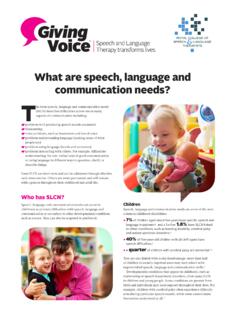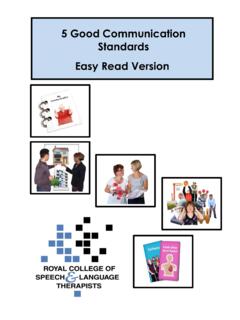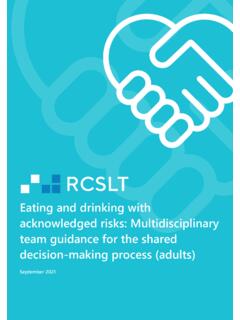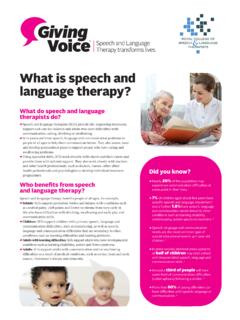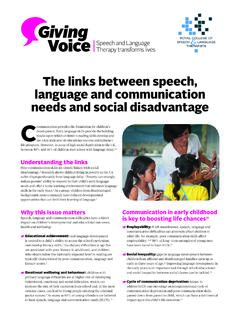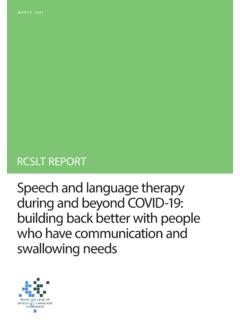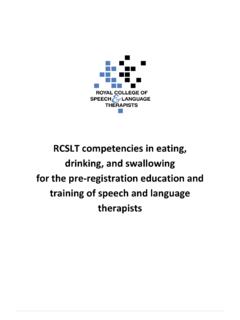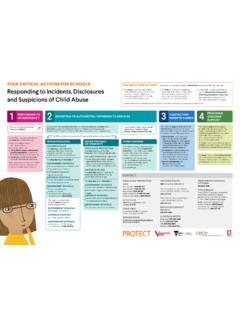Transcription of Understanding the links between communication and …
1 Behaviour is communication . Many children and young people who have behavioural difficulties, including many of those with social, emotional and mental health needs (SEMH), also have speech, language and communication needs (SLCN). These needs often go unrecognised because behaviour can mask a child or young person s difficulties with communication . Speech and language therapists play a key role in supporting children and young people with behavioural Understanding the links between communication and behaviourproblems and SEMH by identifying their SLCN, advising their families and professionals working with them on how to respond appropriately, and providing direct therapy to those children and young people who need are speech, language and communication needs?
2 SLCN can take many forms, including: problems Understanding what others say; difficulties explaining their actions clearly; not having many words to express feelings; and difficulties with social communication , so they don t know how to join a conversation in the right kind of way. SLCN might be masked by other labels or diagnoses , such as learning does communication have to do with behaviour? communication difficulties are strongly associated with behavioural problems, with studies observing consistently higher levels of disruptive and antisocial behaviour amongst children and young TMUnderstanding the links between communication and behaviour The size of the issue 81% of children with emotional and behavioural disorders (EBD)
3 Have significant unidentified communication 57% of children with diagnosed language deficits are identified with In a study of pupils at risk of exclusion from school, two thirds were found to have Excluded boys had significantly poorer expressive language skills than their peers who had not been excluded from school; many of their difficulties had not previously been More than 60% of young people who are accessing youth justice services present with SLCN which are largely Children with persistent and severe conduct problems are about three times more likely to have low verbal ability than children with a low risk of conduct also identified with , 8, 9, 10 These associations can be understood by considering the impact of SLCN on the skills and abilities a child or young person needs to behave appropriately.
4 UnderstandingChildren and young people with SLCN often have problems Understanding what others say to them for example, Understanding instructions and Understanding things that are not directly stated. They may also have difficulties Understanding indirect requests. These children may then appear to be uncooperative, disobedient or oppositional, when in fact they have not understood an instruction or the broader It can be harder for them to learn new words, and words for thoughts and feelings. Expressive language Children and young people with SLCN can have a variety of expressive language difficulties, such as: stammering; selective mutism; difficulty finding the right words; and problems constructing sentences or a clear narrative, all of which can be misinterpreted Those who are hesitant and revise their sentences might be seen as untruthful.
5 Memory and concentrationChildren and young people with SLCN often have poor working memory abilities, meaning they are more prone to distractions and require repetition of information. These difficulties can often be interpreted as laziness or a wilful desire to frustrate teachers and Emotional regulationLanguage is important for emotional ,15 Children and young people with SLCN may have difficulties finding the words which describe their own feelings, and can find it hard to cope with their emotions and calm themselves. Language skills are also needed to understand our own and other peoples thoughts16 and feelings,17 which are important for behaving in the expected way.
6 Social interactionChildren and young people with SLCN may struggle to understand jokes, idioms (for example, get a grip ) and sarcasm, all of which are important for social interaction. They may also have difficulties Understanding the rules of conversation, including how to repair misunderstandings when they This can be partly due to slow processing, which leads them to miss cues and means their turn taking is mistimed. Understanding behaviour as communicationNegative behaviour in children and young people with SLCN could mean:The risks of not supporting speech, language and communication needsUnidentified and unsupported SLCN put children and young people at risk of a range of negative outcomes in relation to behaviour: Difficulties forming friendships, resulting in fewer opportunities to learn how to behave and communicate well.
7 They may be at risk of peer rejection which can lead to further behavioural problems19I don t understand what you want me to doThis work is too hard for meI know you don t understand me and its making me very anxiousI can t explain what I meanI can t understand my feelings or do anything about themI m in a fight again and I don t know how to make it better Literacy difficulties which impact on school work Exclusion from school20 Involvement in the youth justice system21 Increased risk of being bullied or being a bully Effect on emotional wellbeingIn addition, behaviour assessments and interventions which are language based, such as anger management and cognitive behavioural therapy, and other talking therapies place significant demand on language Unless children s SLCN are identified and their needs accommodated, assessments risk delivering inaccurate results, and treatment programmes risk being ineffective.
8 Research has shown that: verbally-based behavioural interventions may not be effective with young people who have unidentified communication needs;23, 24 and un-adapted group interventions may be challenging and therefore less effective for those with social communication speech and language therapy can promote positive behaviour Speech and language therapists have a key role to play in promoting positive behaviour and reducing the risk of negative behaviour by enabling the following. Greater Understanding of communication needs Working collaboratively with other staff to understand the skills gaps and emotional needs which may underlie behaviour problems.
9 Acting as an advocate for the child or young person, helping others to understand their communication needs. Ensuring that procedures and policies regarding de-escalation, positive handling and debriefing are accessible to children and young people with s storyJ was receiving individual support in the inclusion / nurture house at a secondary school for children with social, emotional and mental health (SEMH) needs, as he was not able to mix with other students. A previous attempt to reintegrate J into a mainstream school had been unsuccessful, and he returned to the secondary SEMH school, but with lengthy periods of absence.
10 The speech and language therapist assessed J and, on the basis of that assessment, proposed that J might benefit from a social skills group at another mainstream school. The speech and language therapist arranged for this to be set up and as a result the student s attendance and participation subsequently increased. Training on how to adapt teaching and support Providing communication -friendly environments, including by modelling appropriate interactions and language. Sharing effective vocabulary teaching strategies , ensuring children and young people understand the language of the classroom and vocabulary around behaviour management.
